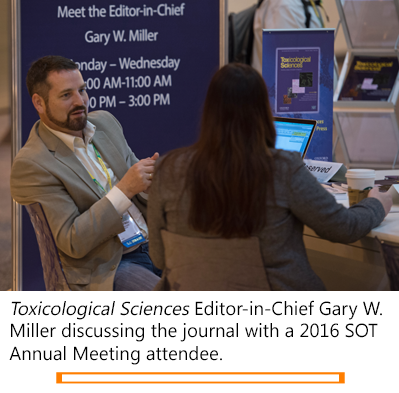
As we progress through the year, Council continues to concentrate its efforts on the goals of our strategic plan and our current mega focus of enhancing the Society’s efforts to increase the stature and recognition of toxicology among other biomedical disciplines. Achievement of the mega focus goals will be ensured by successful efforts in multiple strategic objectives, including fostering the integration of other scientific disciplines with toxicology; bridging existing and emerging science in toxicology; increasing mutual understanding among toxicologists and other disciplines; communicating the impact and relevance of toxicology with key audiences; and increasing partnerships/collaboration with scientific societies. All of these center on the need to foster communication, understanding, and collaboration across interdisciplinary lines. In the current era of team science and the need for integrated multidisciplinary approaches to solve complex problems, the importance of fostering meaningful and respectful scientific interactions becomes ever more important.
Many of the ongoing efforts of the Society are well targeted towards this goal. Our Annual Meeting continues to be the premiere venue for state-of-the-art toxicological knowledge. Our revised plenary speaker format fosters interdisciplinary knowledge and understanding by bringing outstanding scientists in relevant fields to present their most recent advances. Last year, our Plenary Session topics included breakthroughs in stem cell science and neurobiology. This year’s plenary lectures include sessions focused on precision medicine, data science, and the exposome and metabolic profiling. Not only will these sessions bring cutting-edge science to our members, but also, by highlighting modern toxicological science to our speakers, we spread the good work that we do to outstanding scientists in other fields.
 Our journal, Toxicological Sciences, is a key tool to communicate advances in our field to the scientific community. The journal provides original and hypothesis-driven research articles, as well as highly valuable contemporary reviews of toxicological issues of importance. I am delighted to note that exciting things are happening at Toxicological Sciences. In partnership with Oxford University Press, we are moving to a new web platform for the journal (launching in December 2016), which includes several new functions to enhance the user experience. This provides me with the opportunity to encourage members to submit their best research manuscripts to our journal. One of most recognized journals in the field, Toxicological Sciences provides rapid review and turnaround of manuscripts and, perhaps most importantly, provides peer reviews by scientists who truly understand toxicology and its importance in improving public and environmental health. The stronger the articles in our journal, the greater the impact the journal will have throughout the biomedical community.
Our journal, Toxicological Sciences, is a key tool to communicate advances in our field to the scientific community. The journal provides original and hypothesis-driven research articles, as well as highly valuable contemporary reviews of toxicological issues of importance. I am delighted to note that exciting things are happening at Toxicological Sciences. In partnership with Oxford University Press, we are moving to a new web platform for the journal (launching in December 2016), which includes several new functions to enhance the user experience. This provides me with the opportunity to encourage members to submit their best research manuscripts to our journal. One of most recognized journals in the field, Toxicological Sciences provides rapid review and turnaround of manuscripts and, perhaps most importantly, provides peer reviews by scientists who truly understand toxicology and its importance in improving public and environmental health. The stronger the articles in our journal, the greater the impact the journal will have throughout the biomedical community.
Another exemplary communication effort of our society is the SOT FDA colloquium series. Initiated in 2014, this series consists of four half-day sessions throughout the year, providing cutting-edge knowledge in toxicology for US Food and Drug Administration (FDA) risk assessors and managers, as well as other attendees who participate either on-site or via webcast. The series has drawn more than 2,500 participants from more than 20 countries. This is truly a stellar example of how the Society can communicate advances in our field to key audiences. The Society is grateful for the ongoing efforts of the small working group of SOT members who ensure the continuing success of this important venture.
Integration throughout the larger biomedical community requires that we network effectively. In this regard we are actively pursuing options for better networking. Specifically, Council is exploring ways we could become more involved and effective in AAAS. We also are exploring the possibility of joining federations of biomedical societies. Participation in federations may offer us the opportunity to effectively publicize our Annual Meeting and CCT meetings to scientists of diverse interests; the opportunity for SOT and its members to develop individual symposia or stand-alone meetings that will reach a broader community of scientists; and effectively advocating for key overarching issues, such as the use of animals in research, research integrity, and reducing the research regulatory burden, all of which would serve our Society’s strategic goals. In essence, if toxicology is to be fully participatory and recognized within the broad scope of biomedical sciences, we need a seat at the table of key interdisciplinary federations and organizations.
Toxicology is but one of many biomedical disciplines focused on improving human and environmental health. Our Society’s goals of communicating and further advancing our science are critical to our long-term success. In particular, our Annual Meeting, our journal, and our outreach efforts as exemplified by the ongoing SOT FDA Colloquia highlight the continuing efforts to communicate and advance our science. Through these and future efforts, our goal is to ensure the Society remains an effective voice and advocate for the value of our science as an essential discipline to ensure a safer and healthier world.